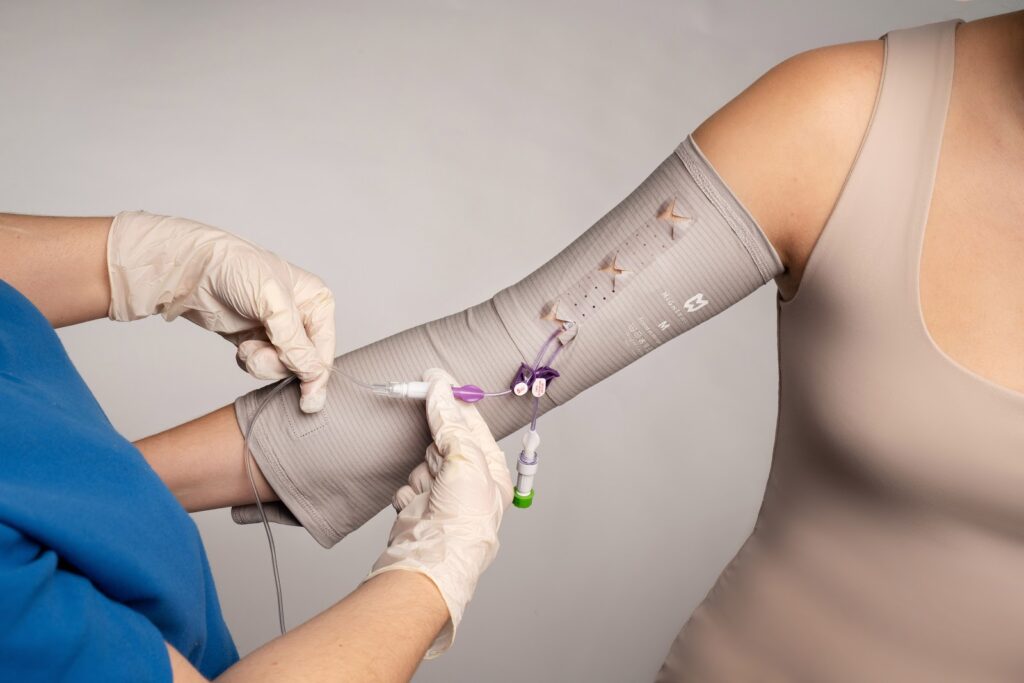Any new medical intervention comes with some fears. The best way to calm these fears is to learn as much as you can ahead of time! PICC placement is no different — the more you know, the more confident you will feel walking into the procedure.
A PICC (Peripherally Inserted Central Catheter) line is a thin tube inserted through the veins in your arm into larger veins near your heart. It is often used when patients need frequent IV treatments, to minimize pain and damage to the veins from frequent needles.
We know how it feels to be facing this type of procedure, so we’ve put together our Ultimate Guide to PICCs video, followed by a list of what to expect for PICC placement:
1. Preparing for PICC placement
Before you get your PICC line placed, your doctor will want to have all of the information that they need. Depending on your case, this might mean getting blood tests or imaging. You will likely have an appointment ahead of time to discuss your medical history and make sure they know all of your specific concerns and risk factors. Be sure to mention if you’ve had challenges with your skin or arms, and communicate how active your lifestyle is.
To get the most out of these preparational appointments, we recommend putting together a list of questions and concerns. Write down the answers in the appointment so that you can revisit them later when you’re feeling nervous. It may be helpful to have someone else in the room with you to take notes so you can stay present and listen. You can learn more here about how to get the most out of your doctor visits.
2. Setting up the PICC placement procedure
Before you head in, make sure you have a plan for things like who will accompany you home and how you will keep your insertion site clean and dry. You will not want to be figuring these things out afterward.
PICC line insertion procedures typically take about an hour and may be done by a doctor, a specialty nurse with PICC placement certification, or another trained medical provider. It will take place in a room with machines for imaging, such as X-rays or ultrasounds.
You’ll lie on your back on a procedure table, with your arm resting on a board for support. The provider will sterilize your arm and will inject a local anesthetic just under your skin. It may sting or burn, but after just a few seconds your arm will be numb and you’ll only feel pressure during the procedure.
3. Insertion of the PICC
Your provider will use imaging to determine the right vein and placement for the PICC line insertion site. It will be above your elbow, likely on your non-dominant arm. With visuals and your arm numb, the thin tube called a catheter will be inserted into your vein through a small hole in your skin. It will then be threaded through your vein up towards your heart. You won’t feel any pain, so just breathe and stay calm as they do their job! When it’s done, you may have more imaging for confirmation that everything is in the right spot. The catheter will stick out of your arm at the insertion site. A cap will be placed at the end of the tube to keep it germ-free.
4. PICC line care instructions
Once the PICC is placed, your provider will review how to care for your line and they will discuss what is expected of you and your caregivers. It’s always helpful to have someone else in the room to listen and take notes, as you may be a bit overwhelmed after the procedure is complete. You may be asked to avoid certain activities, such as lifting heavy objects, throwing a ball, or submerging your arm in water. You will be given a temporary PICC line cover and will be taught how to check the area for infections and flush the line to keep it clear.
For more details, check out how to change your PICC line dressing.

5. Heading home
You will likely be able to go home soon after the PICC line has been placed, but plan to take plenty of time to rest. Your arm will be numb, and then sore and swollen. It may be difficult to put on a jacket or get clothes over your head for a few days. But don’t worry — that’s normal! The swelling will go away within a week or so.
There is a risk of infection at the insertion site of a PICC line, so you’ll want to be careful, but it can largely be avoided through proper care. Follow your provider’s instructions, and don’t hesitate to reach out for clarification if you’re worried. Most importantly, keep the site clean and dry. Use a PICC line cover to keep things safe and secure, and to give yourself peace of mind. If you find your skin is irritated by the tapes and other products used to keep things in place, talk to your doctor for other options. We’ve put together a list of some favorites here!
Click here for Two PICC Line Complications to Watch Out For.
Helpful resources:
PICC lines are common enough that there are plenty of resources available if you’re looking to learn more. YouTube and hospital webpages have PICC line placement videos you can watch.
For more information, personal stories, and patient tips, head to our blog, or join our Friends in the Fight Facebook group to meet people who’ve been there!
We’ve compiled a list of premium PICC products that can make it easier to care for your PICC.
We wish you the best of luck — and informed preparation — with your procedure! You’ve got this ?

